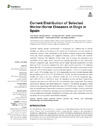Identificador persistente para citar o vincular este elemento:
https://accedacris.ulpgc.es/jspui/handle/10553/75079
| Título: | Current distribution of selected vector-borne diseases in dogs in Spain | Autores/as: | Montoya Alonso, José Alberto Morchon Garcia,Rodrigo Costa Rodríguez, Noelia Matos Rivero, Jorge Isidoro Falcón Cordón, Yaiza Carretón, Elena |
Clasificación UNESCO: | 320712 Parasitología | Palabras clave: | Dirofilaria immitis Leishmania infantum Anaplasma spp. Ehrlichia canis Epidemiology, et al. |
Fecha de publicación: | 2020 | Publicación seriada: | Frontiers in Veterinary Science | Resumen: | Currently, climate change, modifications of landscapes and habitats due to human activities, as well as an increase in the movement of reservoirs and new species of competent vectors, have contributed to the spread of canine vector-borne diseases. These are mostly emerging and neglected diseases, some of them with zoonotic potential. Therefore, the objective of this study was to assess the prevalence and distribution of four major canine vector-borne diseases (Dirofilaria immitis, Leishmania infantum, Anaplasma spp., and Ehrlichia canis) in Spain. Between September 2018 and February 2020, blood was sampled from 4643 client-owned dogs from 111 veterinary clinics from the 17 autonomous communities of Spain. All samples were tested for the detection of D. immitis antigens, and for antibodies against L. infantum, Anaplasma spp. and E. canis. Of the studied dogs, 22.14% were positive for one or several diseases while the prevalence was 6.25% (CI: 5.59–6.98) for D. immitis, and the seroprevalences were 10.36% (CI: 9.52–11.27) for L. infantum, 5.06% (CI: 4.47–5.73) for Anaplasma spp., and 4.26% (CI: 3.72–4.88) for E. canis. Co-infections by two and three vector-borne diseases were reported in 13% and 2% of the infected dogs, respectively. The studied vector-borne diseases are widely distributed throughout the Spanish geography, being observed and expanding northward in the case of D. immitis and L. infantum. The results point to an insufficiency of preventive measures to avoid the infection, and the need of the implementation of awareness campaigns among veterinarians and owners. Furthermore, a close collaboration between veterinarians, physicians and health authorities would be necessary for such zoonotic vector-borne diseases. | URI: | https://accedacris.ulpgc.es/handle/10553/75079 | ISSN: | 2297-1769 | DOI: | 10.3389/fvets.2020.564429 | Fuente: | Frontiers in Veterinary Science [ISSN 2297-1769], v. 7 |
| Colección: | Artículos |
Citas SCOPUSTM
42
actualizado el 08-jun-2025
Citas de WEB OF SCIENCETM
Citations
42
actualizado el 08-jun-2025
Visitas
147
actualizado el 13-abr-2024
Descargas
93
actualizado el 13-abr-2024
Google ScholarTM
Verifica
Altmetric
Comparte
Exporta metadatos
Los elementos en ULPGC accedaCRIS están protegidos por derechos de autor con todos los derechos reservados, a menos que se indique lo contrario.
